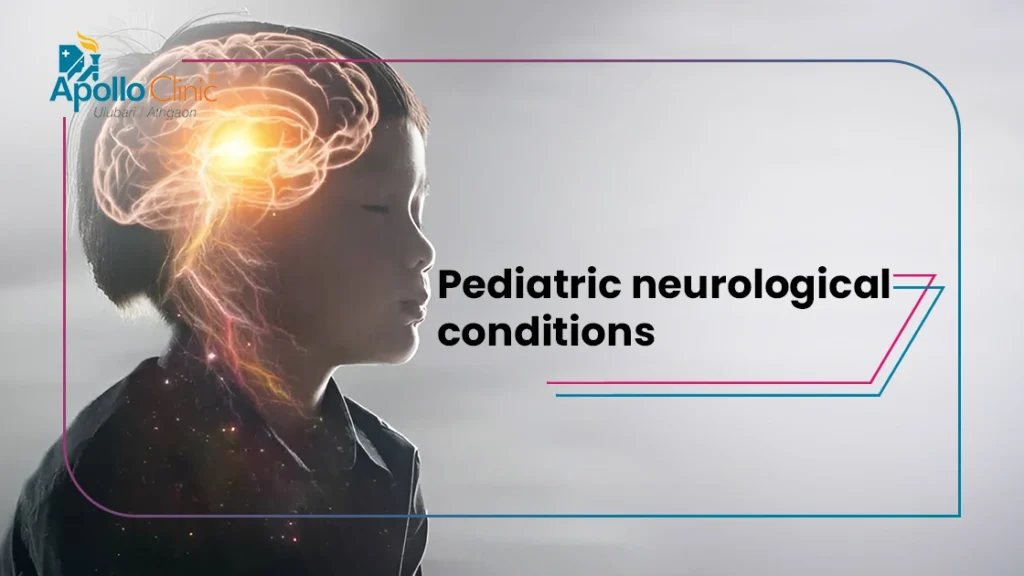As a parent, you’re your child’s greatest advocate. Recognizing the early signs of pediatric neurological conditions can make a significant difference in their care and development. By understanding the potential symptoms and seeking appropriate medical attention, you can help your child receive the support they need to thrive.
Moreover, the early childhood years are a period of rapid growth and development, which sets the foundation for lifelong health. Moreover, the brain, spinal cord, and nerves, the nervous system play an important role in controlling bodily functions, promoting cognitive and motor skills in the child. However, neurological disorders occur when there are abnormalities in the brain, nervous system, or muscle cells.
Consequently, these disorders cause unique challenges for both affected children and their families.
In this blog post, we’ll explore 10 common disorders that affect young minds and bodies. Also, we delve into the complexities of neurological disorders in children, exploring their causes, diagnosis, and potential treatments.
What are Childhood Neurological Conditions?
In simple words, childhood neurological conditions can affect the brain, spinal cord, and nerves. Also, they often manifest in developmental, cognitive, behavioral, or physical abnormalities. Moreover, these disorders can arise from various factors, including genetic predisposition, prenatal exposures, infections, traumatic injuries, and metabolic abnormalities.
10 Common Neurological Disorders in Pediatrics
Neurological disorders in children are conditions that affect the brain, spinal cord, and nerves. We can see these disorders in various ways, including developmental delays, seizures, movement disorders, and learning disabilities.
Here is a list of common neurological disorders:
- Autism Spectrum Disorder (ASD) are developmental disorder characterized by challenges in social interaction, communication, and repetitive behaviors. Also, it mostly appears in early childhood and can vary widely in severity and presentation.
- Attention Deficit Hyperactivity Disorder (ADHD) are neurodevelopmental disorder. Also, it is indicated by inattention, hyperactivity, and impulsivity. Generally, it starts in childhood and can last into adolescence and adulthood.
- Cerebral Palsy (CP) is a group of movement disorders that appear in early childhood. Moreover, it is caused by abnormal development or damage to the parts of the brain that control movement.
- Epilepsy and Seizures are characterized by recurrent seizures. However, seizures are caused by abnormal electrical activity in the brain and can vary in severity and type.
- Down Syndrome is a genetic disorder caused by the existence of an extra chromosome 21. Also, children with Down syndrome usually experience cognitive delays and characteristic facial features and may have heart defects and gastrointestinal issues.
- Spina Bifida is a congenital condition where the spinal cord and its surrounding structures do not develop properly. Therefore, it can result in varying degrees of physical and neurological disabilities.
- Muscular Dystrophy (MD) are genetic disorder characterized by progressive muscle weakness and degeneration.
- Dyslexia is a specific learning disability that affects both reading and language processing skills. Also, children with dyslexia may struggle with decoding words, spelling, and reading fluency.
- Pediatric Stroke: Strokes can occur in children, leading to neurological deficits such as weakness, paralysis, speech difficulties, and cognitive impairments.
- Dyspraxia (Developmental Coordination Disorder) is a neurological condition that affects movement and coordination. Children with dyspraxia may have difficulty with writing, tying shoelaces, or playing sports.
Common Causes of Pediatric Neurological Disorders
A multitude of factors, both genetic and environmental, can create Neuro disorders in children. Therefore, understanding the various causes is important for diagnosis, treatment, and prevention efforts.
Some common causes of neurological disorders in children:
- Genetic Factors which means they can be inherited from one or both parents. Also, genetic mutations or abnormalities in specific genes can lead to Down syndrome, Rett syndrome, muscular dystrophy, and neurofibromatosis.
- Prenatal Factors can occur during pregnancy affect fetal brain development and increase the risk of neurological disorders. Moreover, these factors include maternal infections (such as rubella or cytomegalovirus), exposure to toxins, maternal malnutrition, and complications during pregnancy.
- Perinatal Factors occur around the time of birth and can also contribute to neurological disorders in children. So, perinatal factors include oxygen deprivation, trauma during birth, umbilical cord accidents, and infections acquired during delivery.
- Postnatal Factors can also develop after birth. Also, these may include traumatic brain injuries, infections, exposure to toxins or environmental pollutants, nutritional deficiencies, and metabolic disorders.
- Infections, both prenatal and postnatal, can directly affect the central nervous system and lead to neurological disorders in children. Moreover, infections include bacterial infections, viral infections, parasitic infections, and fungal infections.
- Traumatic brain injuries resulting from accidents falls, and sports-related injuries can cause neurological damage and lead to cognitive impairments, motor deficits, and behavioral changes.
- Autoimmune Disorders make the body’s immune system mistakenly attack its tissues, including the nervous system, leading to autoimmune neurological disorders such as multiple sclerosis (MS), Guillain barre syndrome, and acute disseminated encephalomyelitis (ADEM).
- Metabolic disorders involve abnormalities in biochemical processes that can affect the function of the nervous system causing phenylketonuria (PKU), maple syrup urine disease (MSUD), and mitochondrial disorders.
- Environmental Factors such as environmental toxins, pollutants, or substances during critical periods of brain development can increase the risk of neurological disorders.
Early Symptoms of Neurological Disorders in Children
Symptoms of neurological disorders in children depend on the specific condition, its severity, and the age of onset. Moreover, these symptoms may affect various aspects of a child’s development, including motor function, understanding, behavior, communication, and sensory processing.
Common symptoms indicating problems in children:
- Developmental Delays are delays in developmental milestones, such as sitting up, crawling, walking, talking, or reaching cognitive milestones like understanding language or social cues.
- Motor Deficits are abnormalities in muscle weakness, stiffness, floppiness, tremors, poor coordination, difficulties with balance and gait, and involuntary movements.
- Seizures are abnormal electrical disturbances in the brain that can be convulsions, staring spells, repetitive movements, altered consciousness, or sudden changes in behavior.
- Intellectual Disabilities are below-average intellectual functioning, and difficulties with reasoning, problem-solving, memory, attention, and learning compared to peers of the same age.
- Speech and Language Impairments are problems with speech production, language comprehension, articulation, fluency, or expressive communication.
- Sensory Processing Issues are heightened or diminished sensitivity to sensory stimuli. Also, these include sounds, lights, textures, tastes, or smells, which may lead to sensory seeking or avoidance behaviors.
- Behavioral Challenges are problems such as impulsivity, hyperactivity, aggression, self-injurious behaviors, anxiety, depression, social withdrawal, obsessive-compulsive behaviors, or difficulties with emotional regulation.
- Cognitive Impairments concern attention, memory, executive function (planning, organization, inhibition), problem-solving, or academic performance.
- Communication Disorders are problems in using or understanding language, including social use of language, speech sound disorders, language comprehension insufficiencies, or difficulties with nonverbal communication (gestures, facial expressions).
- Neurological Deficits are weakness or paralysis in one or more limbs, changes in muscle tone, abnormal reflexes, vision or hearing impairments, or loss of sensation.
Diagnosis of Neurological Disorders in Pediatrics
Doctors need comprehensive evaluation to detect neurological disorders in children including medical history, developmental milestones, neurological examination findings, and diagnostic tests. Therefore, pediatricians, neurologists, and other healthcare professionals collaborate to assess and determine the cause of the child’s condition.
- Medical History helps identify any prenatal or perinatal factors, family history of neurological disorders, and past medical events that may be relevant to the child’s current symptoms.
- Developmental Assessment provides valuable insights into a child’s neurodevelopmental trajectory and helps identify any delays or regressions that may indicate an underlying neurological disorder.
- Neurological Examination evaluates the child’s cognitive function, motor skills, coordination, reflexes, and sensory responses, providing important clues to the nature and severity of their neurological condition.
- Diagnostic Tests may include neuroimaging (such as MRI or CT scans), electroencephalography (EEG), genetic testing, metabolic screening, etc.
Treatment of Neurological Disorders
In simple terms, pediatric neurological diseases are conditions affecting the brain, spinal cord, and nerves in children. Moreover, these types of disorders cause a wide range of symptoms. The treatment of neurological disorders in children may involve a combination of medical management, therapy, and supportive interventions:
- Doctors may prescribe medications to manage neurological disorders in children to control symptoms such as seizures, spasticity, or behavioral disturbances.
- Therapy helps in managing neurological disorders and promotes optimal development. Also, these may include physiotherapy, occupational therapy, speech therapy, and behavioral therapy.
- Doctors may suggest surgical interventions to treat neurological disorders, such as epilepsy surgery to remove epileptic foci or neurosurgical procedures to address structural abnormalities in the brain or spinal cord.
- Many children with neurological disorders can benefit from a range of supportive services. Also, these include special education programs, assistive devices, and access to community resources and support groups that cater to their specific needs.
Warning Signs of Neuro-related Diseases
It may be hard to differentiate between what is normal childhood development versus symptoms that may indicate a related disorder. Consequently, it is critical to speak with your child’s pediatrician if you notice any significant changes in your child’s mood, behavior, social skills, or cognitive development that have become more frequent over a sustained period.
However, there are common warning signs to look for if you believe your child is struggling with neuro neuro-related disease or condition.
Common warning signs include:
- Sadness and loss of interest
- attention, focus, and concentration difficulty or hyperactivity
- Continually thinking about harming oneself (self-harm or suicidal thinking)
- Withdrawing from or avoiding social interactions
- Emotional or behavioral outbursts and reactivity (anger, irritability, impulsivity)
- Major changes in mood, behavior, or personality
- Noticeable changes in eating habits
- Abnormal weight loss or weight gain
- Sleep disturbance
- Frequent somatic complaints (stomachache, headache, chronic pain)
- Changes in academic performance
- Skipping school
Pediatric Neurology Medicine List
Doctors often prescribe medicines for pediatric neurological disorders to manage symptoms, improve quality of life, and address underlying conditions. Moreover, the medications prescribed will depend on the individual child’s diagnosis, age, weight, and overall health.
Some common medications used in pediatric neurology:
Anticonvulsants
- Used for: Epilepsy, seizures
- Examples: Phenytoin, carbamazepine, valproic acid, levetiracetam
Stimulants
- Used for: Attention Deficit Hyperactivity Disorder (ADHD)
- Examples: Methylphenidate (Ritalin), amphetamine (Adderall)
Antidepressants
- Used for: Depression, anxiety, obsessive-compulsive disorder (OCD)
- Examples: Selective serotonin reuptake inhibitors (SSRIs), tricyclic antidepressants (TCAs)
Antipsychotics
- Used for: Autism spectrum disorder (ASD), Tourette syndrome, bipolar disorder
- Examples: Risperidone, aripiprazole
Muscle Relaxants
- Used for: Cerebral palsy, spasticity
- Examples: Baclofen, diazepam
Anticholinergics
- Used for: Movement disorders, tics
- Examples: Benztropine, trihexyphenidyl
Important Considerations:
- Dosage: Medications are often prescribed in specific dosages based on the child’s weight and age.
- Side Effects: All medications can have side effects. It’s important to discuss potential side effects with your child’s doctor.
- Monitoring: Regular follow-up appointments are essential to monitor the effectiveness of medications and adjust dosages as needed.
- Combined Therapies: In some cases, a combination of medications may be necessary to manage complex conditions.
Conclusion
It is crucial to understand the common neurological conditions that can affect children for early identification, intervention, and support. By raising awareness, and promoting inclusivity, we can empower children with neurological disorders to thrive and reach their full potential. Let’s work together to create a supportive world for all children, regardless of their neurological differences.
Don’t hesitate to reach out with your concerns or questions about your child’s neurological health. Contact the top neurological specialist near you at Apollo Clinic Ulubari and take the first step towards promoting your child’s well-being and maximizing their potential.











